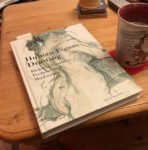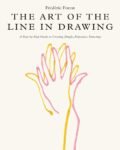On to the last of my Christmas books. I've been looking forward to this one…

The Artist’s Complete Guide To Figure Drawing, Anthony Ryder – Book Review
I’ve just finished the second of the four books I got for my birthday and am ready to review it now. I’m taking my time over these books, reading other stuff in between rather than giving in to temptation and bingereading.
So next up is this one on figure drawing by Anthony Ryder. It’s a 160 page paperback and after being first published in 2000 is still in print, so I’m hoping it’s something pretty special. With there being no need for any coloured images, this one is all in black and white and on matte rather than glossy paper. I’ve seen people complaining on Amazon about this book being in cheap paper but it’s perfectly fine. I wouldn’t have even noticed the difference if I’d not read those reviews. That Jack Hamm book on landscapes still wears the cheap paper crown.
Contents-wise, bookended between an intro and an outro, we have roughly:
- 5 pages on the drawing method
- 10 pages on materials and basic techniques
- 20 pages on the block-in
- 20 pages on gesture
- 25 pages on the contour
- 30 pages on light & shadow theory
- 20 pages on seeing forms, light and shadows on the body
- 25 pages on the process of filling in the outline of the body with light and shadow
The drawing process within the book is a three step one:
- the block-in which, as you may have seen on a preview on Amazon, starts with an envelope, a polygon with a maximum of six sides encompassing the figure. This polygon then gets gradually shaved down and divided until we arrive at a robotic looking figure outline, made up of straight lines.
- the contouring, where the block-in of straight lines is replaced with an outline made up of lots of curves
- drawing on the inside, filling in the contour outline with gradations of light and shadow to create the three dimensional forms that make up the human body.
And while this all sounds straightforward and obvious, it’s not an approach I’ve read about before. Huston, Legaspi and Graves either start from 3D shapes or move quickly into them after starting with stick figures. Charles Reid starts with an outline and fills it but his outlines are based on freehand contour drawing rather than drawing over block-in shapes that started life as an envelope. I had been feeling guilty about starting all my figure paintings from outlines but not any longer! In fact I could continue to use grids to create block-in shapes and then follow steps two and three of Anthony’s plan if I ever found that envelopes didn’t work for me. To put it another way, Anthony’s starting point is much closer to mine than any of the other authors’ are, so I’m already liking this book.
The chapter on gesture was interesting. Other authors seem to think artists should be slaves to gesture, starting drawings with big sweeping curves with the pencil. I guess that works if drawing superhero comics from the imagination but I’m reluctant to draw that way from photos. And I think Anthony thinks the same way. Anthony talks about these “inner curves” but only really as something to be aware of. He seems more focused in this chapter on being aware of which muscles are relaxed and which are tight and reflecting this in the curvature of the edges in the outline contour.
The light and colour theory included lots of stuff I’ve read about before (most notably in the James Gurney book) about highlights, terminators, reflected light, cast shadows, dark accents, etc but what was great about this book is that we’re given so many examples of theses in Anthony’s drawings and that we get to see that applying this theory in practice really does make drawings more realistic. And this theory keeps getting referred to as we move on to the drawing in the inside stage.
Throughout the book we get lots of tips: there’s plenty to learn here. I was particullarly impressed with some of the details of how to turn a block-in into a contour outline and with what landmarks we’re told to look for on the human body when filling in the outline. We’re even presented with portraits in places, where the same methodology still works; I was so into the book by this point that I didn’t even question why we were talking about portraits in a book on figure drawing. And the lessons in this book apply to all the different media I use, albeit to different extents and least of all to markers, with which any artist would struggle to get gradations of shade.
Maybe the biggest lesson from this book was that we should take our time over figure drawings. Other books talk about models holding poses for a maximum of ten minutes and artists needing to work quickly, “capturing the gesture” and producing scribbled doodles. Not Anthony though. He typically takes 36 hours to do one of this drawings. 36 hours! It means there’s no shame in me taking so long over some of my coloured pencil drawings and that, if anything, I should slow down a bit.
Voice-wise, this was reyt oop my street. I’ve seen people complaining about this on Amazon, but Anthony’s use of random bits of imagery was something that I found entertaining and illuminating. Sometimes the imagery says more than words ever could, and this is a tenet I made good use of in conference presentations back in my working days. Anthony’s half page Basil Fawlty rant about the nose was sheer poetry and something that will live with me forever.
Marks-wise, this gets the full five palettes. It’s my favourite figure drawing book. Not just because it has a similar approach to me, making it more useful but also because I think it’s easier for beginners to draw outlines and fill them in than to look at a model and picture them as a bulked up stickman or a bunch of sausages. This one comes highly recommended.
🎨🎨🎨🎨🎨
You can find this book and more reviews of it at Amazon UK here. As an Amazon Associate, I earn commission from qualifying purchases but this costs absolutely nothing extra to you.








Leave a Reply